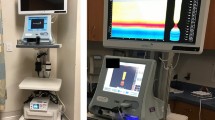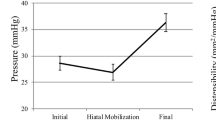Abstract
Background
The functional lumen imaging probe (FLIP) uses impedance planimetry to measure the geometry of a distensible organ. The purpose of this study was to evaluate FLIP as a method to determine structural changes at the gastroesophageal junction (GEJ) following transoral incisionless fundoplication (TIF) and compare these findings with the accepted methods of esophageal testing.
Methods
Two different approaches (TIF1.0 and 2.0) using the EsophyX™ device were performed in six and five animals, respectively. Three dogs underwent a sham procedure. FLIP measurements were performed pre- and post-procedure and at 2-week follow-up. Upper endoscopy, manometry, and 48-h pH testing were also performed at each time point. FLIP was performed in ten patients before and 3 months after TIF.
Results
Following TIF procedures, there was a significant decrease in cross-sectional area (CSA) of GEJ compared to baseline; however, the CSA of both groups returned to baseline at 2-week follow-up. The FLIP results were supported with pH testing and correlated highly with both measures of GEJ structural integrity (LES and cardia circumference). Following TIF in humans, there was a decrease in GEJ distensibility compared to baseline that persisted to the 3-month evaluation.
Conclusion
FLIP is able to measure and display changes in tissue distensibility at the GEJ, and results correlate with established methods of testing. FLIP may represent a single testing modality by which to diagnose GERD and evaluate the outcome after antireflux surgery.






Similar content being viewed by others
References
McMahon BP, Frokjaer JB, Kunwald P, et al. The functional lumen imaging probe (FLIP) for evaluation of the esophagogastric junction. Am J Physiol Gastrointest Liver Physiol. 2007;292(1):G377-84.
Cadiere GB, Rajan A, Rqibate M, et al. Endoluminal fundoplication (ELF)--evolution of EsophyX, a new surgical device for transoral surgery. Minim Invasive Ther Allied Technol. 2006;15(6):348–55.
Harris LD, Pope CE, 2nd. "Squeeze" Vs. Resistance: An Evaluation of the Mechanism of Sphincter Competence. J Clin Invest. 1964;43:2272–8.
Jobe BA, O'Rourke RW, McMahon BP, Gravesen F, Lorenzo C, Hunter GJ, Bronner M, Kraemer JMS. Transoral endoscopic fundoplication in the treatment of gastroesophageal reflux disease: the anatomic and physiologic basis for reconstruction of the esophagogastric junction using a novel device. Ann Surg. 2008;248(1):69–76.
Cadiere GB, Buset M, Muls V, et al (2008) Antireflux Transoral Incisionless Fundoplication Using EsophyX: 12-Month Results of a Prospective Multicenter Study. World J Surg 32(8):1676–1688.
Hollenbeck JI, Maher JW, Wickbom G, Bushkin FL, McGuigan JE, Woodward ER. The effect of feeding on the canine lower esophageal sphincter. Journal of Surgical Research. 1975;18(5):497–9.
Watrous BJ, Suter PF. Normal Swallowing on the Dog: A Cineradiographic Study. Veterinary Radiology and Ultrasound. 1979;20(3–6):99–109.
McMahon RL, Ali A, Chekan EG, et al. A canine model of gastroesophageal reflux disease (GERD). Surg Endosc. 2002;16(1):67–74.
Jobe BA, Kahrilas PJ, Vernon AH, et al. Endoscopic appraisal of the gastroesophageal valve after antireflux surgery. Am J Gastroenterol. 2004;99:233–243.
Hill LD, Kozarek RA, Kraemer SJM, et al. The gastroesophageal flap valve: in vitro and in vivo observations. Gastrointest Endosc. 1996;44:541–547.
Seltman AK, Kahrilas PJ, Chang EY, et al. Endoscopic measurement of cardia circumference as an indicator of GERD. Gastrointest Endosc 2006;63:22–31.
Kwiateck MA, Pandolfino JE, Hirano I, Kahrilas PJ (2010) Esophagogastric junction distensibility assessed with an endoscopic functional lumen imaging probe (EndoFLIP). Gastrointest Endosc 72:272–8.
Jobe BA, Kahrilas PJ, Vermon AH, et al (2004) Endoscopic appraisal of the gastroesophageal valve after antireflux surgery. Am J Gastroenterol 99(2):233–43.
Jacob BP, Dakin G, Divino D, et al. Long-term follow-up evaluation for a canine model of gastroesophageal reflux disease. Surg Endosc 2003;17:354.
Author information
Authors and Affiliations
Corresponding author
Additional information
This paper was presented at the 51st annual meeting of The Society for Surgery of Alimentary Tract, May 4, 2010, New Orleans, Louisiana.
Rights and permissions
About this article
Cite this article
Hoppo, T., McMahon, B.P., Witteman, B.P.L. et al. Functional Lumen Imaging Probe to Assess Geometric Changes in the Esophagogastric Junction Following Endolumenal Fundoplication. J Gastrointest Surg 15, 1112–1120 (2011). https://doi.org/10.1007/s11605-011-1562-2
Received:
Accepted:
Published:
Issue Date:
DOI: https://doi.org/10.1007/s11605-011-1562-2




